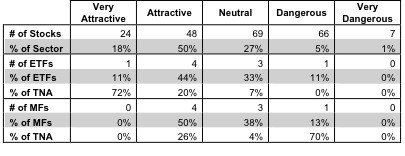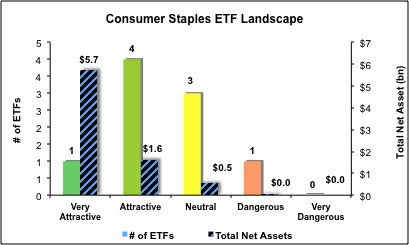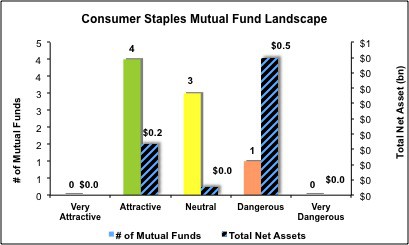The Consumer Staples sector ranks first out of the ten sectors as detailed in my Sector Rankings for ETFs and mutual funds. It gets my Attractive rating, which is based on aggregation of ratings of nine ETFs and eight mutual funds in the Consumer Staples sector as of January 23rd, 2013. Prior reports on the best & worst ETFs and mutual funds in every sector and style are here.
Figures 1 and 2 rank all eight ETFs and all six mutual funds in the sector that meet our liquidity standards. Not all Consumer Staples sector ETFs and mutual funds are created the same. The number of holdings varies widely (from 22 to 120), which creates drastically different investment implications and ratings. The best ETFs and mutual funds allocate more value to Attractive-or-better-rated stocks than the worst ETFs and mutual funds, which allocate too much value to Neutral-or-worse-rated stocks.
To identify the best and avoid the worst ETFs and mutual funds within the Consumer Staples sector, investors need a predictive rating based on (1) stocks ratings of the holdings and (2) the all-in expensesof each ETF and mutual fund. Investors need not rely on backward-looking ratings. My fund rating methodology is detailed here.
Investors seeking exposure to the Consumer Staples sector should buy one of the Attractive-or-better rated ETFs or mutual funds from Figures 1 and 2.
Get my ratings on all ETFs and mutual funds in this sector on my free mutual fund and ETF screener.
Figure 1: ETFs with the Best & Worst Ratings
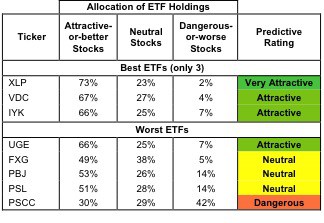 * Best ETFs exclude ETFs with TNAs less than $100 million for inadequate liquidity.
* Best ETFs exclude ETFs with TNAs less than $100 million for inadequate liquidity.
Sources: New Constructs, LLC and company filings
Rydex S&P Equal Weight Consumer Staples ETF (RHS) is excluded from Figure 1 because its total net assets (TNA) are below $100 million and do not meet our liquidity standards.
Figure 2: Mutual Funds with the Best & Worst Ratings – Top 5
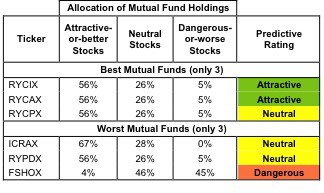 * Best mutual funds exclude funds with TNAs less than $100 million for inadequate liquidity.
* Best mutual funds exclude funds with TNAs less than $100 million for inadequate liquidity.
Sources: New Constructs, LLC and company filings
ICON Funds: ICON Consumer Staples Fund (ICLEX, ICLCX) is excluded from Figure 2 because its total net assets (TNA) are below $100 million and do not meet our liquidity standards.
Consumer Staples Select Sector SPDR (XLP) is my top-rated Consumer Staples ETF and earns my Very Attractive Rating. Rydex Series Funds: Consumer Products Fund (RYCIX) is my top-rated Consumer Staples mutual fund and earns my Attractive rating.
PowerShares S&P SmallCap Consumer Staples Portfolio (PSCC) is my worst-rated Consumer Staples ETF and Fidelity Select Portfolios: Construction & Housing Portfolio (FSHOX) is my worst-rated Consumer Staples mutual fund. Both earn my Dangerous rating.
Figure 3 shows that 72 out of the 214 stocks (over 68% of the total net assets) held by Consumer Staples ETFs and mutual funds get an Attractive-or-better rating. Upon further inspection, we see that investors are putting money in the best Consumer Staples ETFs as 92% of total net assets are in Attractive or Very Attractive-rated ETFs. On the other hand, investors are not putting their money in the best Consumer Staples mutual funds as less than 26% of total net assets are in Attractive-or-better rated mutual funds. More ETFs (five out of nine) earn an Attractive-or-better rating than mutual funds (four out of eight) in this sector. That comparison suggests Consumer Staples portfolio managers are not deserving of their fees.
Figure 3: Consumer Staples Sector Landscape For ETFs, Mutual Funds & Stocks
As detailed in “Cheap Funds Dupe Investors”, the fund industry offers many cheap funds but very few funds with high-quality stocks, or with what I call good portfolio management.
As noted above, investors need to tread carefully when considering Consumer Staples ETFs and mutual funds, as the overall Attractive sector rating does not mean all ETFs and mutual funds in this sector earn Attractive ratings.
Philip Morris International, Inc. (PM) is one of my favorite stocks held by Consumer Staples ETFs and mutual funds and earns my Very Attractive rating. It has a top quintile ROIC of 36% and rising economic earnings.
The current share price of ~$88.84 implies that the market expects a permanent, albeit slight, decline in PM’s profitability over the next year. Revenue growth of 1.2% and an economic earnings margin (ROIC-WACC) of 29% over the next year, both of which are inferior to last year’s performance, would correspond to a share price of just over $111, which would result in a nice gain for investors.
TreeHouse Foods, Inc. (THS) is one of my least favorite stocks held by Consumer Staples ETFs and mutual funds and earns my Very Dangerous rating. THS has a consistently poor economic earningsmargin (-2.1% over the past five years) but has seen its share price more than double over that same time. It appears THS investors must be focused on the company’s revenue growth, which, at 15.4% compounded annually over the last five years, is impressive. However, THS can increase its revenue all it wants, but without positive economic earnings there is no shareholder value creation and no economic justification for its current valuation.
124 stocks of the 3000+ I cover are classified as Consumer Staples stocks, but due to style drift, Consumer Staples ETFs and mutual funds hold 214 stocks.
Figures 4 and 5 show the rating landscape of all Consumer Staples ETFs and mutual funds.
Our Sector Rankings for ETFs and mutual funds report ranks all sectors and highlights those that offer the best investments.
Figure 4: Separating the Best ETFs From the Worst ETFs
Figure 5: Separating the Best Mutual Funds From the Worst Mutual Funds
Review my full list of ratings and rankings along with reports on all nine ETFs and eight mutual funds in the Consumer Staples sector.
Sam McBride contributed to this article
Disclosure: David Trainer owns PM. Neither David Trainer nor Sam McBride receives any compensation to write about any specific stock, sector or theme.

